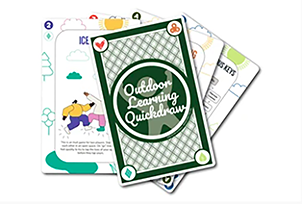Page Content

Spending time outdoors promotes physical and mental health for teachers and students
Information provided by members of the ATA’s Health and Physical Education Council (HPEC) and Global, Environmental and Outdoor Education Council (GEOEC).
FOR TEACHERS, THE LAST FEW years have been incredibly challenging. As a result, many of us have increased our awareness and the consideration we give to moving students from indoor learning environments to the outdoors where both teachers and students feel more safe from the potential of being exposed to COVID. It has been a cultural shift. Many teachers who, in the past, may not have felt comfortable outdoors with their students have now begun to lean into opportunities to be outside with their students more often. Teachers (and their students) are becoming more aware of the positive outcomes that being outdoors provides to personal well-being.
GO OUT AND EXPLORE
In terms of educating the whole child, being outdoors benefits the physical, affective, cognitive and social domains. Time spent outdoors is associated with an increase in moderate to vigorous physical activity and improved cardiorespiratory fitness. Both adults and youth who spend time outdoors report improved general health and better mental health. Social free play and outdoor learning sessions with teachers boost emotional resilience, self-regulation, emotional well-being and academic performance. Student–student relationships and student–teacher relationships are also perceived to be stronger when a portion of the instructional day is spent outdoors, year-round. Simply put, outdoor activities bear multiple benefits to teachers, students and society at large.
When you are planning your next outdoor adventures with your students, we recommend taking a comprehensive school health approach, which includes four interrelated components: policy, teaching and learning, social and physical environments, and partnership and services. Outdoor teaching and learning opportunities may look different depending on your learners, your subject discipline and how you approach the learning outcomes. The great outdoors truly fits all and should be considered a teacher. There are many cross-curricular links to time spent in nature.
Look for opportunities to connect socially while outdoors. Walk-and-talk meetings and debriefing activities are great ways to connect with others. When students and staff feel connected to their school, they experience higher levels of perceived success and well-being.
Move outside and get to know all aspects of the physical environment surrounding your school. Look for access to natural spaces in close proximity where you could visit with your students, and encourage your students to help you locate those places. Consider traffic, trees, playgrounds and trails—make some time to explore your 2.4. The majority of school jurisdictions specify a radius of 1.6 to 2.4 kilometres as the “walk zone,” depending on the grade configuration. Go out and explore!
References are available upon request by emailing section editor Shelley Svidal: shelley.svidal@ata.ab.ca.
“Nature has always been there for us, waiting. We simply need to return to her for healing.”
— Elder Bob Cardinal, 2021

Get some help
To get you started, here are some recommended resources from the ATA’s Health and Physical Education Council (HPEC), the Global, Environmental and Outdoor Education Council (GEOEC) and Ever Active Schools:
- HPEC website to connect and collaborate: hpec.ab.ca
- GEOEC website for resources, including a Mini Guide to Winter Nature: geoec.org/lesson-ideas.html
- Outdoor Learning Quickdraw: This resource is designed to provide activity and lesson ideas for classes of any age and subject area to try outside. There are four suits with 13 cards each: physical literacy, outdoor skills, teamwork and environmental action.
RECOMMENDED RESOURCE

Joy at Work
Marie Kondo and Scott Sonenshein
Available through the ATA library.
